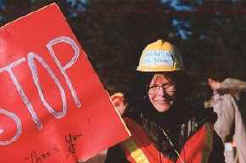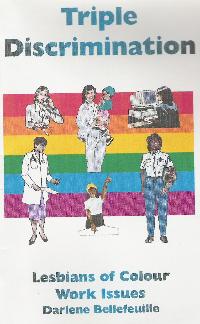Stereotypes
The
basis of most of the problems in gender differences is our
tendency to stereotype people. Stereotypes
aren't all bad; they make our lives easier. When we stereotype all
citrus juice as "sour but necessary morning beverage" we
ease our decision-making process for facing the morning
("Will I
drink orange juice again this morning?").
Where
it goes wrong is when we stereotype people based on their gender,
sexual orientation,
race, ethnic group, religion, geographical
region of origin, or any other of a number of categories.
You cannot ever say, "All x people are y." When we act
on those stereotypes to ensure that a particular kind of person
does not get a fair shake, that is discrimination and often also
harassment. Stereotypes
abound, in addition to and most often in combination with those about
gender.
Race
- Black
women suffer from additional stereotypes that men (and sometimes
women) hold about
them. A black female colleague tells the story of "sand and
sea, and rum" -- the stereotypical view and assumptions of too many men
about women of colour. She was at a social/business gathering when
a client sidled up to her, drink in hand, murmuring, "sand
and sea, sand and sea."
 |
She had absolutely no idea what he
was talking about until someone later told her that the guy was
insinuating that because she was black, she must come from an
exotic island where she basks in the sun and drinks rum all day. |
These stereotypes can be disastrous to a woman's career. No matter
what you do, it's not enough. If you ignore them, the perpetrators
assume they have a right to continue. If you speak up, you're
labelled a complainer.
This
is the same colleague who, when working as a high-powered
management consultant, was waiting in the reception area for the client she
had come to see. The receptionist had announced her, he had said
he would be right out. When he arrived, he looked around the room,
said to the receptionist, "There's no one here." These
stories happened in the 1990's, not the 1890's. Racism or sexism
is bad enough; together they are a deadly combination. Black
women also suffer from stereotypes that black men hold about
them.
Even
seemingly "good" stereotypes can have evil effects. The
Asian male who is stereotyped as "brilliant at math" may
not see this as a compliment when he is struggling to pass tenth
grade geometry and feels a more miserable failure because he is
supposed to be good at it. In addition to the burdensome
stereotype of the "super-minority," Asian
myths also include the dangerous one of docility for women.
 |
Exercise
Bad Stereotyping |
Give an example
of "bad"
stereotyping in relation to men and
women in management.
Post your answer in the
Moodle
Discussion Group.
|
|
 |
Exercise
"Good" Stereotyping |
Give an example
of the so-called "good
stereotyping" in relation to men and
women in management.
Post your answer in the
Moodle
Discussion Group.
|
|
First
Nations women suffer from a dichotomous stereotype; one is
either an overworked squaw or a Cherokee princess. The assumption
that a First Nations man will automatically have a problem with
alcohol is demeaning and dangerous.
Class
is a source of stereotypes rampant in
our supposedly class-free society. Was your father a working man?
Did your mother's family come from "the wrong side of the
tracks?" Does your brother work as a labourer? Are you the
first person in your family ever to go to university?
At
some time in my family history, every one of those statements has
been true for someone. Yet I am a University professor, a member of the
supposed "elite." York is not quite so
snobbish about the "grove of academe" as some other
universities in the city (which shall remain nameless) but we've
got our share of class snobbery. During the 1997 YUFA strike,
while captaining the exceptionally dangerous Sentinel Road picket
line on the late evening shift, I wore
| the safety equipment I'm
required to wear in my academic research, which is on trucks --
yellow hard hat and steel-toed boots. I didn't wear these
for effect; I wore them for safety. I literally stood in the middle of the east
lane of Sentinel Road between two moving streams of cars, |
 |
many
filled with angry anti-union drivers. I wore that equipment for safety, yet
there were many YUFA colleagues who could not abide the fact that
I wore a "WORKING MAN'S HAT." (For those who may not
know, yellow is the working person's hat, white is the
supervisor's hat, and green is often the environmental control
person's hat). I took a lot of grief over my "working class
hat" and listened to (too) many always male York professors talk about
how we shouldn't even be on strike because it made us look
like _____________ (steelworkers, longshoremen, coal miners
-- you fill in the blank and be sure to say it with a long and
arrogant sniff of your turned-up nose) and you'll get the
idea. All work is honourable; all work is important. Classism has
no place in Canadian society. Why did only men object? I'm not
sure, but it may have to do with the macho image of the
construction worker as well - consider the extreme amount of
prejudice that women in the construction trades face.
Sexual
Orientation also provides avenues for
stereotyping. Do all gay men drink to
excess and have seventeen new partners each evening? My colleague
Steven at Simon Fraser University in B.C. does not; my shoestring brother Milt who came
out of the closet a quarter century ago does not;
many of my close friends are gay men and none of them live this
lifestyle that the heterosexist community likes to push
onto them. I realize this is anecdotal evidence, but by the
rules of logic, while you cannot prove a thing is universally true
solely by citing one example, you can prove it is NOT
universally true by citing examples where it is not so.
Lesbians?
Well, everyone knows, right?
No you don't, and don't even presume to think you do if you aren't
one or close to one.
Triple Discrimination
If you think it's
difficult dealing with discrimination as a woman, or as a person of
colour, or as a gay or lesbian, consider the case of the person facing
all three.
| A student who took this course the year of the
1997 YUFA strike touched my heart deeply by choosing my class to
come out.
She produced a booklet for that class on triple
discrimination (she is female, black, and lesbian), which she later
published and we used in the course. Below is
a quote from that booklet. |
 |
|
"Minority women are subject to preconceived stereotypes long
before they are given the chance to succeed in their chosen
profession or even interviewed for the job. Furthermore, lesbians
differ in many aspects from the traditional roles that
heterosexual women often conform to and sometimes benefit from.
While white women have to deal with sexism in their place of
business, lesbians of colour encounter sexism, racism, and
homophobia."
|
 |
Exercise
Sexual Orientation |
What can a good manager do about the things we tend to take for granted in organizations,
such as social events, that
automatically tend to exclude or make life difficult for
gays and lesbians?
Post your answer in the
Moodle
Discussion Group.
|
|
Straight
White Men
don't get off easily either. Who could
possibly measure up to John Wayne or Sergeant Preston of the Northwest
Mounted Police?!
I
have colleagues (and a husband!) who shudder in horror that I even
mention Robert Bly's Iron
John in a women's studies class, but I highly
recommend it if you want to hear at least one view of men in today's
world and how the way they have been socialized and stereotyped from early youth
can affect the way they treat women and the way they suffer in
their lives.
Click here to read something about Robert Bly's book, Iron John
 |
Exercise
Iron John |
Relate the review of Iron John. What are your reactions?
Can you relate it to gender in management?
Post your
answer in the
Moodle
Discussion Group. |
|
Sheryl Sandberg's Book Lean
In
 |
Exercise
Sandberg Stereotypes |
How does
Sheryl Sandbert's book Lean In help you further
understand the topic of this unit?
Post your answer in the
Moodle Discussion
Group. |
|